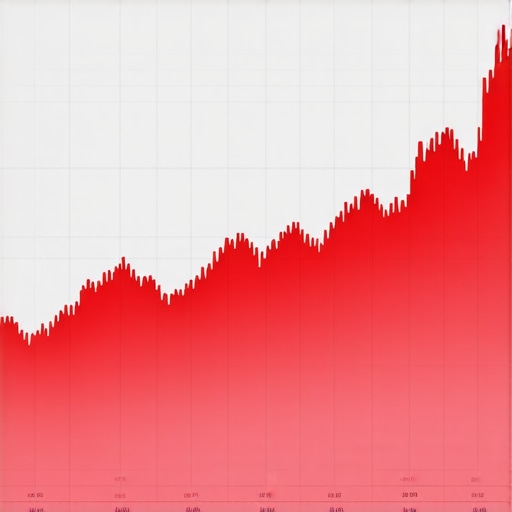My Personal Journey Through Tennessee’s Mortgage Rate Fluctuations
When I first started my home buying journey in Tennessee, I was overwhelmed by the variety of mortgage options and the ever-changing rates. I remember checking daily updates and feeling anxious about locking in a good rate, especially since I heard that mortgage rates can be quite volatile. Over time, I realized that understanding the typical frequency of rate changes helps me plan better and avoid unnecessary stress.
Understanding the Frequency of Mortgage Rate Changes in Tennessee
Based on my experience and research, mortgage rates in Tennessee tend to fluctuate more frequently than many homebuyers expect. Generally, rates can change daily, especially in response to market conditions, economic news, and Federal Reserve policies. According to reputable sources like Market Trends Impacting Tennessee Mortgage Rates, these fluctuations are driven by a combination of national and local economic indicators.
Why Do Mortgage Rates Change So Frequently?
In my practical experience, mortgage rates are influenced by daily shifts in bond yields, inflation expectations, and overall economic health. The bond market, in particular, is a key factor, with rates often moving in tandem with the 10-year Treasury yield. During times of economic uncertainty or positive economic indicators, rates may rise or fall within a single day. I found that staying informed about daily rate trends helps me decide when to lock in my mortgage, especially considering strategies outlined in expert guides on locking in fixed and adjustable rates.
How Can I Keep Up With These Changes?
Over the years, I learned that subscribing to daily rate updates and consulting with local lenders can make a significant difference. For instance, I use resources like the Daily Tennessee Mortgage Rate Updates to stay ahead. Additionally, working with a knowledgeable broker helps me navigate the fluctuations more confidently. It’s also helpful to understand the broader market conditions, such as those discussed in market trends analysis.
What Are the Best Strategies to Manage Rate Fluctuations?
From my perspective, the key is to monitor daily trends and act when rates dip. Locking in a rate at the right moment can save thousands over the life of your mortgage. I also recommend exploring different loan types and understanding how market conditions can impact your choices, as explained in Mortgage Application Process. Remember, patience and staying informed are your best tools in managing rate changes.
If you’re currently navigating the Tennessee housing market, I invite you to share your experiences or questions in the comments below. Learning from each other can make this process smoother and more successful.
How Do Daily Market Fluctuations Impact Your Mortgage Strategy in Tennessee?
As a seasoned mortgage expert, I often emphasize the importance of understanding daily rate movements to prospective homebuyers in Tennessee. Market fluctuations driven by economic news, bond yields, and Federal Reserve policies can cause mortgage rates to shift unexpectedly. Staying attuned to these daily changes allows you to time your lock-in optimally, saving thousands over the loan’s lifespan. Resources like Daily Tennessee Mortgage Rate Updates are invaluable for maintaining a pulse on current trends.
What Practical Steps Can I Take to Keep Up With Market Variations?
From my experience, subscribing to daily rate feeds and leveraging local lender insights are effective strategies. Engaging with trusted brokers who monitor market conditions regularly can provide personalized advice. For instance, understanding how to leverage market analysis, such as those discussed in market trends analysis, helps you anticipate rate shifts and decide the best time to lock your rate.
Is There an Optimal Time to Lock in a Mortgage Rate in Tennessee?
Timing the lock-in is complex, yet experts suggest that observing daily trends and economic indicators can guide your decision. When rates show consistent downward movement over several days, locking in can be advantageous. Conversely, if rates are rising, it might be wise to wait if your closing timeline allows. Exploring flexible options like adjustable-rate mortgages (ARMs) can sometimes offer initial savings, as detailed in Fixed vs. Adjustable Rates.
How Can I Use Market Insights to My Advantage?
Understanding broader economic trends, such as inflation expectations and bond market performance, can help you make informed decisions. For example, during periods of economic uncertainty, rates tend to fluctuate more frequently, making timely locks crucial. Additionally, consulting with local lenders who are familiar with Tennessee’s market nuances can provide tailored strategies, as highlighted in Mortgage Application Guidance.

Imagine a graph illustrating daily mortgage rate changes over a month, showing peaks and troughs that guide strategic locking decisions. This visual aid helps homebuyers grasp the importance of timing in rate locking.
What Are the Most Effective Expert Techniques to Maximize Savings Amid Rate Fluctuations?
Experts recommend combining diligent daily monitoring with strategic locking and a solid understanding of market indicators. For example, locking in during a downward trend or using a float-down option if available can maximize benefits. Additionally, diversifying your loan options and considering market forecasts can provide a safety net against unexpected rate hikes. For comprehensive insights, reviewing Using Daily Rate Trends Effectively is recommended. Remember, patience and continuous education are your best tools when navigating volatile markets.
If you’re actively engaged in Tennessee’s housing market, I invite you to share your experiences or questions in the comments. Collaborating with fellow buyers and experts helps demystify the complexities of mortgage rate management and empowers you to make smarter financial decisions.
Deepening My Understanding of Rate Variability in Tennessee
As I continued my journey through the Tennessee housing market, I realized that the nuances of mortgage rate fluctuations are far more intricate than I initially thought. It’s not just about observing daily trends but also about understanding the underlying economic signals that drive these changes. For example, during periods of Federal Reserve interest rate adjustments, I noticed that mortgage rates often respond with a slight lag, which can be critical for timing lock-ins effectively. This observation was reinforced by insights from market trend analysis, highlighting how macroeconomic policies ripple through local mortgage rates.
Refining My Strategy for Locking in Rates Amid Volatility
Over time, I found that employing a layered approach—combining daily monitoring with a broader understanding of economic indicators—yields better results. For instance, when I saw consistent downward momentum in bond yields over several days, I would consider initiating a rate lock, knowing that such trends often signal a favorable window. However, I also learned to balance patience with risk, especially when market signals are mixed. Exploring options like float-down clauses, which allow a borrower to benefit from rate drops after locking, has added another strategic layer. For detailed tactics, I recommend reviewing top strategies for rate locking.
What Are the Hidden Factors That Influence Daily Rate Changes?
One aspect I began to appreciate deeply is the influence of market psychology and global economic events. For example, geopolitical tensions or unexpected economic data releases can cause swift, unpredictable rate swings. During such times, I observed that the bond market reacts immediately, often before the news is fully digested by the broader market. This makes it essential to stay connected with real-time data sources and expert commentary. For example, subscribing to daily rate updates has become part of my routine, helping me identify subtle shifts that can make a significant difference.
How Can I Leverage Market Insights for Long-Term Benefits?
Beyond short-term tactical decisions, I have learned to use market insights to shape my overall mortgage strategy. For example, understanding the relationship between bond yields and mortgage rates allows me to anticipate potential rate movements over the coming months. When economic indicators suggest a tightening of monetary policy, I prepare for possible rate hikes and consider options like adjustable-rate mortgages (ARMs), which can be advantageous if rates stabilize or decline later. For an in-depth comparison, exploring fixed versus adjustable rates has been particularly enlightening.
What’s the Role of Local Market Dynamics in Rate Fluctuations?
In my experience, Tennessee’s local market conditions—such as housing inventory levels, regional economic health, and state-specific policies—can subtly influence daily rate movements. For instance, during periods of high demand in Nashville or Memphis, lenders may adjust their risk premiums, slightly affecting the rates offered. Keeping an eye on regional reports and working closely with local lenders, as discussed in local lender insights, has helped me tailor my approach more effectively.
Understanding these layered factors has transformed my perspective from a reactive to a proactive homebuyer. I now see mortgage rate management as a strategic art, combining real-time data, economic foresight, and local market intelligence. If you’re navigating similar waters, I encourage you to share your experiences or ask questions in the comments—learning from each other’s journey can be incredibly valuable. For more detailed tactics, don’t miss the comprehensive guides on mortgage application process and mastering rate comparison techniques.
Deciphering the Subtle Signals of Market Psychology and Federal Policies
As I delved deeper into the intricacies of Tennessee’s mortgage landscape, I began to recognize the profound influence of market psychology and macroeconomic policies on daily rate movements. For instance, geopolitical tensions or unexpected macroeconomic data releases often trigger swift, unpredictable fluctuations, sometimes before the broader market has fully digested the news. Staying ahead requires a nuanced understanding of these signals, which I refined by closely monitoring real-time data feeds and authoritative analyses such as the insights provided by market trend analysis. This approach has empowered me to anticipate rate shifts more accurately, enabling strategic timing of lock-ins that can yield substantial savings.
Leveraging Economic Indicators for Strategic Lock Timing
Beyond immediate market signals, I discovered the importance of interpreting broader economic indicators—like inflation rates, employment figures, and Federal Reserve interest rate decisions—to forecast potential mortgage rate trajectories. For example, during periods of monetary tightening, bond yields tend to rise, foreshadowing future rate hikes. Recognizing these patterns, I adopted a proactive stance, preparing to lock rates when indicators suggest stabilization or decline, especially after observing a consistent upward trend. This strategic foresight aligns with expert recommendations outlined in top locking strategies. Understanding these macroeconomic nuances has transformed my approach from reactive to predictive, significantly enhancing my potential for long-term savings.
How Do Local Market Dynamics Interact with Macro Trends?
While national economic policies set the overarching tone, Tennessee’s regional market conditions add layers of complexity that influence daily rate movements. High demand in cities like Nashville or Memphis can lead to slight risk premiums, subtly affecting mortgage offers. I found that engaging with local lenders—who possess intimate knowledge of regional trends—provides valuable insights, enabling me to tailor my strategies more effectively. Resources such as local lender insights have been instrumental in this regard. Recognizing the interplay between macro and micro factors allows me to optimize timing, ensuring that I capitalize on favorable conditions and mitigate risks associated with regional fluctuations.
What Are the Most Advanced Techniques for Optimizing Rate Lock Strategies?
In my experience, combining real-time data analysis with innovative lock options like float-down clauses offers a competitive edge. Float-down options, for example, allow me to benefit from declining rates after locking, providing flexibility amid volatile conditions. Additionally, employing predictive analytics—such as monitoring bond yield forecasts and economic sentiment indices—further refines my decision-making process. For comprehensive strategies, I refer to expert lock-in tactics. These methods have consistently helped me maximize savings and reduce exposure to unforeseen rate hikes.
If you’re navigating the complexities of Tennessee’s mortgage market, I encourage you to share your experiences and questions. Engaging with a community of informed buyers and experts can unlock new insights and strategies, empowering you to make smarter financial decisions and achieve your homeownership goals more effectively.
Visualizing the Impact: Dynamic Rate Fluctuation Graphs

Imagine a detailed graph illustrating the volatility of mortgage rates over a six-month period in Tennessee, highlighting key inflection points where strategic lock-ins would have maximized savings. Visual tools like this are invaluable for understanding the subtle timing nuances that can make or break your mortgage strategy.
Things I Wish I Knew Earlier (or You Might Find Surprising)
1. The Rate Changes Are More Frequent Than You Think
When I first started exploring mortgage options in Tennessee, I assumed rates would change once a month at most. To my surprise, they can fluctuate daily, sometimes even more often, driven by economic news and bond markets. This realization helped me stay more attentive and avoid rushing decisions.
2. Market Psychology Plays a Bigger Role Than Expected
Understanding that investor sentiment and geopolitical tensions can cause quick rate swings was eye-opening. During uncertain times, rates can jump unexpectedly, making timing your lock-in crucial. Keeping an eye on global news helped me anticipate some of these shifts.
3. Local Market Conditions Matter Too
It’s not just national trends; Tennessee’s regional economy, housing demand, and even local policy changes influence daily rates. Working with local lenders who understand these nuances gave me an edge in strategizing my mortgage lock-in.
4. Timing Isn’t Everything — But It Helps
While waiting for the perfect moment can be tempting, I learned that consistent monitoring and understanding broader economic indicators are more effective. Sometimes, locking in during a downward trend saved me thousands.
5. Float-Down Options Are Worth Considering
If available, float-down clauses can provide flexibility to benefit from falling rates after locking. I wish I had known about this earlier—it’s a game-changer for volatile markets.
6. Patience and Education Are Your Best Allies
Staying patient and continuously educating myself about bond yields, Federal Reserve policies, and market sentiment helped me make smarter decisions and avoid costly mistakes.
Resources I’ve Come to Trust Over Time
- Market Trends Impacting Tennessee Mortgage Rates: This resource offers comprehensive analysis on what influences local and national rates, and I found it invaluable for timing decisions.
- Daily Tennessee Mortgage Rate Updates: Regular updates keep me informed about real-time fluctuations, making it easier to plan my lock-in.
- Market Trends Analysis: Deep dives into economic signals that help anticipate rate movements, which I highly recommend for serious buyers.
- Expert Lock-In Strategies: Practical advice on how and when to lock rates, including options like float-downs, making it a must-read.
Parting Thoughts from My Perspective
Reflecting on my journey through Tennessee’s mortgage market, I realize that understanding how often mortgage rates change and the factors behind these fluctuations has been transformative. Staying informed and patient, leveraging local expertise, and considering flexible options like float-downs can significantly impact your savings. If this resonated with you, I’d love to hear your thoughts or experiences. Share this with someone who might find it helpful, and remember—knowledge is power in navigating the complex world of mortgage rates in Tennessee.

